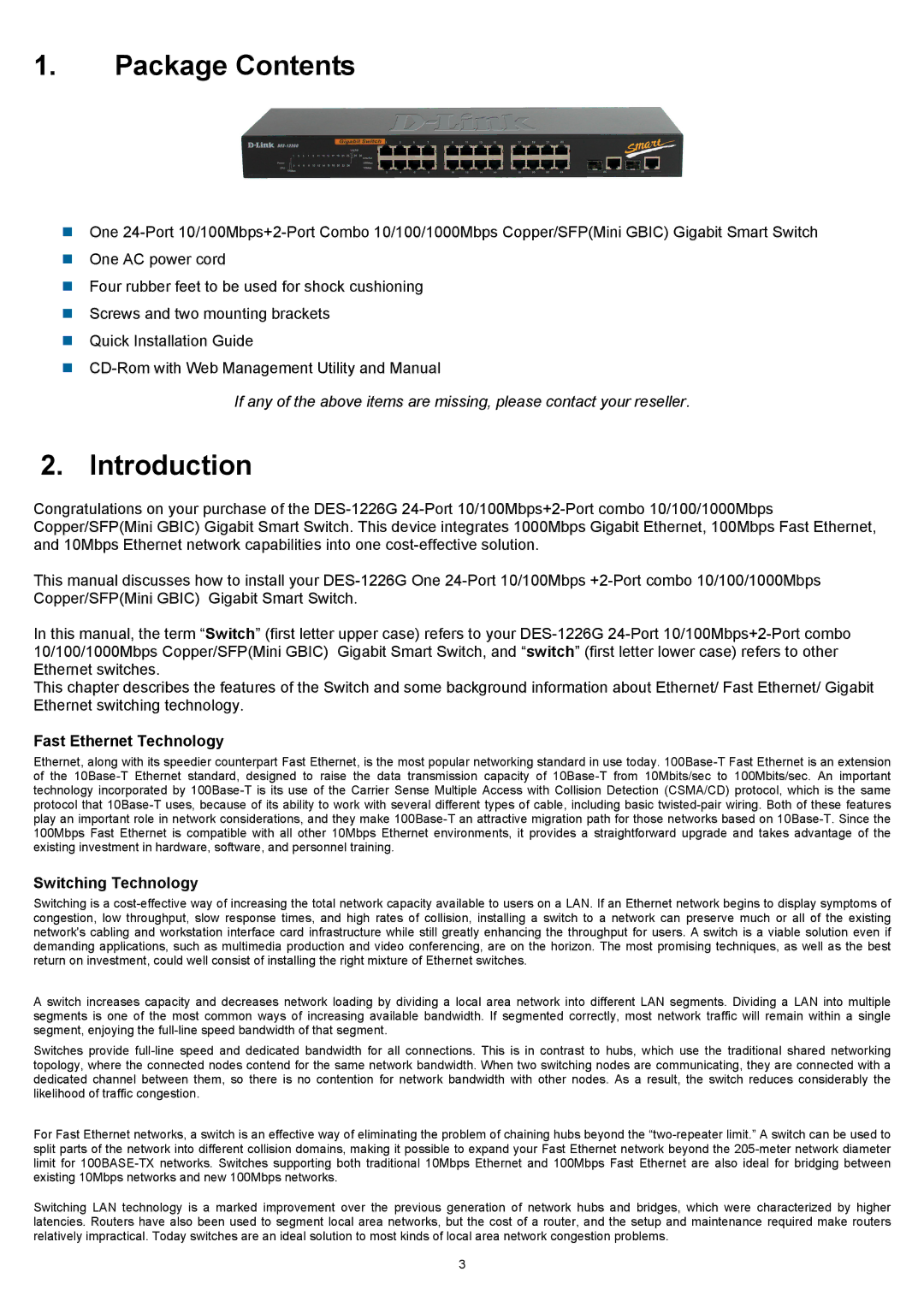1.Package Contents
One 24-Port 10/100Mbps+2-Port Combo 10/100/1000Mbps Copper/SFP(Mini GBIC) Gigabit Smart Switch
One AC power cord
Four rubber feet to be used for shock cushioning
Screws and two mounting brackets
Quick Installation Guide
CD-Rom with Web Management Utility and Manual
If any of the above items are missing, please contact your reseller.
2. Introduction
Congratulations on your purchase of the DES-1226G 24-Port 10/100Mbps+2-Port combo 10/100/1000Mbps Copper/SFP(Mini GBIC) Gigabit Smart Switch. This device integrates 1000Mbps Gigabit Ethernet, 100Mbps Fast Ethernet, and 10Mbps Ethernet network capabilities into one cost-effective solution.
This manual discusses how to install your DES-1226G One 24-Port 10/100Mbps +2-Port combo 10/100/1000Mbps Copper/SFP(Mini GBIC) Gigabit Smart Switch.
In this manual, the term “Switch” (first letter upper case) refers to your DES-1226G 24-Port 10/100Mbps+2-Port combo 10/100/1000Mbps Copper/SFP(Mini GBIC) Gigabit Smart Switch, and “switch” (first letter lower case) refers to other Ethernet switches.
This chapter describes the features of the Switch and some background information about Ethernet/ Fast Ethernet/ Gigabit Ethernet switching technology.
Fast Ethernet Technology
Ethernet, along with its speedier counterpart Fast Ethernet, is the most popular networking standard in use today. 100Base-T Fast Ethernet is an extension of the 10Base-T Ethernet standard, designed to raise the data transmission capacity of 10Base-T from 10Mbits/sec to 100Mbits/sec. An important technology incorporated by 100Base-T is its use of the Carrier Sense Multiple Access with Collision Detection (CSMA/CD) protocol, which is the same protocol that 10Base-T uses, because of its ability to work with several different types of cable, including basic twisted-pair wiring. Both of these features play an important role in network considerations, and they make 100Base-T an attractive migration path for those networks based on 10Base-T. Since the 100Mbps Fast Ethernet is compatible with all other 10Mbps Ethernet environments, it provides a straightforward upgrade and takes advantage of the existing investment in hardware, software, and personnel training.
Switching Technology
Switching is a cost-effective way of increasing the total network capacity available to users on a LAN. If an Ethernet network begins to display symptoms of congestion, low throughput, slow response times, and high rates of collision, installing a switch to a network can preserve much or all of the existing network's cabling and workstation interface card infrastructure while still greatly enhancing the throughput for users. A switch is a viable solution even if demanding applications, such as multimedia production and video conferencing, are on the horizon. The most promising techniques, as well as the best return on investment, could well consist of installing the right mixture of Ethernet switches.
A switch increases capacity and decreases network loading by dividing a local area network into different LAN segments. Dividing a LAN into multiple segments is one of the most common ways of increasing available bandwidth. If segmented correctly, most network traffic will remain within a single segment, enjoying the full-line speed bandwidth of that segment.
Switches provide full-line speed and dedicated bandwidth for all connections. This is in contrast to hubs, which use the traditional shared networking topology, where the connected nodes contend for the same network bandwidth. When two switching nodes are communicating, they are connected with a dedicated channel between them, so there is no contention for network bandwidth with other nodes. As a result, the switch reduces considerably the likelihood of traffic congestion.
For Fast Ethernet networks, a switch is an effective way of eliminating the problem of chaining hubs beyond the “two-repeater limit.” A switch can be used to split parts of the network into different collision domains, making it possible to expand your Fast Ethernet network beyond the 205-meter network diameter limit for 100BASE-TX networks. Switches supporting both traditional 10Mbps Ethernet and 100Mbps Fast Ethernet are also ideal for bridging between existing 10Mbps networks and new 100Mbps networks.
Switching LAN technology is a marked improvement over the previous generation of network hubs and bridges, which were characterized by higher latencies. Routers have also been used to segment local area networks, but the cost of a router, and the setup and maintenance required make routers relatively impractical. Today switches are an ideal solution to most kinds of local area network congestion problems.

